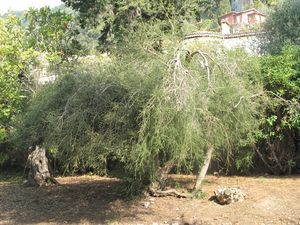Note: This is a project under development. The articles on this wiki are just being initiated and broadly incomplete. You can Help creating new pages.
Difference between revisions of "Melaleuca alternifolia - Tea tree oil"
(→External Links) |
(→Veerya) |
||
| (4 intermediate revisions by 2 users not shown) | |||
| Line 15: | Line 15: | ||
==Common names== | ==Common names== | ||
| − | {{en= | + | {{Common names|kn=|ml=|sa=|ta=|te=|hi=|en=Melaleuca oil}} |
| − | |||
==Properties== | ==Properties== | ||
| Line 27: | Line 26: | ||
===Veerya=== | ===Veerya=== | ||
| + | Ushna (Hot) | ||
===Vipaka=== | ===Vipaka=== | ||
| Line 55: | Line 55: | ||
==Where to get the saplings== | ==Where to get the saplings== | ||
==Mode of Propagation== | ==Mode of Propagation== | ||
| − | + | {{Propagation|Stem}} | |
==How to plant/cultivate== | ==How to plant/cultivate== | ||
| − | + | Seed - surface sow in spring or autumn onto a pot of permanently moist soil in a warm greenhouse. Emmerse in 5cm of water and do not water from overhead. Grow on until the seedlings are 0.5cm tall then remove from the water and pot up a week later. Seedlings are liable to damp off when grown this way, sowing the seed thinly, good ventilation and hygiene are essential for success. <ref name="Cultivation details"/> | |
| − | |||
| − | |||
| − | |||
| − | |||
| − | |||
| − | |||
==Commonly seen growing in areas== | ==Commonly seen growing in areas== | ||
| Line 85: | Line 79: | ||
<ref name="Leaf">[http://www.worldagroforestry.org/treedb/AFTPDFS/Melaleuca_alternifolia.PDF "BOTANIC DESCRIPTION"]</ref> | <ref name="Leaf">[http://www.worldagroforestry.org/treedb/AFTPDFS/Melaleuca_alternifolia.PDF "BOTANIC DESCRIPTION"]</ref> | ||
| + | <ref name="Cultivation details">[https://pfaf.org/USER/Plant.aspx?LatinName=Melaleuca+alternifolia "Cultivation details"]</ref> | ||
Latest revision as of 10:55, 30 May 2020
Tea tree oil (TTO), or melaleuca oil, is an essential oil with a fresh camphoraceous odor and a colour that ranges from pale yellow to nearly colourless and clear.[1] It is taken from the leaves of the Melaleuca alternifolia, which is native to Southeast Queensland and the Northeast coast of New South Wales, Australia.
Tea tree oil is toxic when taken by mouth, but is widely used in low concentrations in cosmetics and skin washes. Tea tree oil has been claimed to be useful for treating a wide variety of medical conditions. It shows some promise as an antimicrobial. Tea tree oil may be effective in a variety of dermatologic conditions, including dandruff, acne, lice, herpes, and other skin infections. However, the quality of the evidence is low.
Contents
- 1 Uses
- 2 Parts Used
- 3 Chemical Composition
- 4 Common names
- 5 Properties
- 6 Habit
- 7 Identification
- 8 List of Ayurvedic medicine in which the herb is used
- 9 Where to get the saplings
- 10 Mode of Propagation
- 11 How to plant/cultivate
- 12 Commonly seen growing in areas
- 13 Photo Gallery
- 14 References
- 15 External Links
Uses
Parts Used
Chemical Composition
Common names
| Language | Common name |
|---|---|
| Kannada | |
| Hindi | |
| Malayalam | |
| Tamil | |
| Telugu | |
| Marathi | NA |
| Gujarathi | NA |
| Punjabi | NA |
| Kashmiri | NA |
| Sanskrit | |
| English | Melaleuca oil |
Properties
Reference: Dravya - Substance, Rasa - Taste, Guna - Qualities, Veerya - Potency, Vipaka - Post-digesion effect, Karma - Pharmacological activity, Prabhava - Therepeutics.
Dravya
Rasa
Guna
Veerya
Ushna (Hot)
Vipaka
Karma
Prabhava
Habit
Identification
Leaf
| Kind | Shape | Feature |
|---|---|---|
| Simple | Variable | variously arranged, scattered to whorled often on one branchlet; petiole 1 mm long; blade linear-acute, 10-35 mm x 1 mm, 3-veined (often only mid-vein visible), puberulous, glabrescent, dotted with oil glands
visible with a lens. |
Flower
| Type | Size | Color and composition | Stamen | More information |
|---|---|---|---|---|
| Bisexual | axillary or terminal spike | Pale yellow | 30-60 | Flowers solitary within each bract with tubular calyx up to 3 mm long and white corolla 2-3 mm long, stamens 30-60, white, clawed, pistil with 3-4 mm long style and capitate stigma. |
Fruit
| Type | Size | Mass | Appearance | Seeds | More information |
|---|---|---|---|---|---|
| A capsule | 2-3mm | a many-seeded, globose, woody capsule, 2-3 mm in diameter | {{{5}}} | {{{6}}} |
Other features
List of Ayurvedic medicine in which the herb is used
Where to get the saplings
Mode of Propagation
How to plant/cultivate
Seed - surface sow in spring or autumn onto a pot of permanently moist soil in a warm greenhouse. Emmerse in 5cm of water and do not water from overhead. Grow on until the seedlings are 0.5cm tall then remove from the water and pot up a week later. Seedlings are liable to damp off when grown this way, sowing the seed thinly, good ventilation and hygiene are essential for success. [2]
Commonly seen growing in areas
Photo Gallery
References
External Links
- Herbs with Oil used in medicine
- Herbs with common name in English
- Habit - Tree
- Index of Plants which can be propagated by Stem
- Herbs that are commonly seen in the region of Tropical area
- Herbs
- Australia
- Ayurvedic herbs that don't have flower, fruit and leaf photos
- Ayurvedic herbs that don't have seed photos
- Myrtaceae




